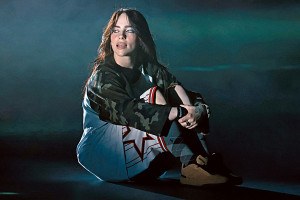“Showdown! Kuniyoshi vs. Kunisada” Opens at the Museum of Fine Arts

Utagawa Kunisada I (Toyokuni III) (Japanese, 1786–1864); Woodblock print (nishiki-e), ink and color on paper, photo courtesy of the Museum of Fine Arts
When budding artist Utagawa Kuniyoshi saw his fellow apprentice, Utagawa Kunisada, float down the river on a boat surrounded by beautiful women, Kuniyoshi resolved to work hard at their shared craft and become just as successful.
Or so the story goes, says Museum of Fine Arts curator of Japanese art, Sarah E. Thompson, who adds that the story may not be true.
True or not, the anecdote characterizes the competitive aspect of the two artists’ relationship and respective careers, something that will be the focus of the MFA’s upcoming exhibition, “Showdown! Kuniyoshi vs. Kunisada.”
In 19th century Japan, Kunisada (1786–1864) and Kuniyoshi (1797–1861) both apprenticed with the same master, Toyokuni, to learn the art of ukiyo-e woodblock prints.
The process involves the collaborative efforts of a designer, an engraver, a printer, and a publisher. Essentially, a publisher would commission a design from the designer, who would create the image on paper. The design would then be etched into wooden blocks, which were used to make prints.
Kunisada and Kuniyoshi were designers. The former’s work consisted mostly of portraits of Kabuki actors and sensual images of beautiful women; the latter, on the other hand, primarily depicted warriors and supernatural monsters. Kunisada—11 years older than Kuniyoshi—was the favorite pupil and became nearly as good as Toyokuni by the time he reached his early 20s. By contrast, Thompson says, Kuniyoshi was considered “just one of the many junior pupils” and was not as popular during his own lifetime.
Today, however, Kuniyoshi might be more popular than his older rival, and Thompson says that’s a result of modern anime and manga. In fact, fans may see the roots of these newer media in Kuniyoshi’s prints; they share elements of epic adventure and supernatural flair that Kuniyoshi helped pioneer.
Despite their differences, the two artists are often compared to one another because they occupied the same sphere and did the same type of work for the same audiences. The two artists had a “natural rivalry,” Thompson says, but they were “not hostile enemies or anything of that kind.”
Instead, their professional competition influenced their respective works, as they picked up on good ideas from each other. Likely inspired by Kuniyoshi’s popular designs of heroes with tattoos, Kunisada depicted actors with tattoos that they probably didn’t have, Thompson says. Conversely, Kunisada was known for his close-up portraits of actors, and in some later prints, Kuniyoshi did close-ups of historical figures.
Later on in their careers, the two worked jointly on certain projects when publishers commissioned some designs from one and some designs from the other. Publishers “were the people who really controlled the business,” Thompson says. “It was very commercial; it was not art for art’s sake.”
Due to Kunisada’s popularity, publishers would produce much larger images for him than for Kuniyoshi, Thompson says. In curating the exhibition, Thompson and her coworkers from Japanese museums were careful not to show the same bias—or any bias, in fact, as they strove to create a balanced exhibition with an equal number of works from each artist.
Several large Kuniyoshi shows already existed in Japan. “We wanted to do something different,” Thompson says, adding that this exhibition, which premiered at the MFA’s sister museum in Japan, was the first in Japan to explicitly compare Kuniyoshi and Kunisada.
The exhibition comes to Boston with some alterations. The curators had to shrink it down from 170 works to 100 due to space constraints at the MFA, and they introduced some works that hadn’t been part of the Japanese exhibitions, such as prints by Kuniyoshi that are suspected to be political cartoons.
In keeping with the “showdown” nature of the exhibition, visitors can expect to see 49 works from Kuniyoshi and 49 from Kunisada. It will also feature one memorial portrait of Kuniyoshi and one of Kunisada, each painted by one of their own students. Visitors are encouraged to decide for themselves who they prefer, and the MFA will measure public opinion through a short quiz asking visitors to select preferred artworks. “Depending on what you pick, at the end, you find that you’re either Team Kuniyoshi or Team Kunisada,” Thompson says.
Curating the show has made Thompson reflect on her own preferences, she says: “It was very interesting working on this show because I’m very fond of Kuniyoshi and have been for a long time—it’s partly because he was a cat lover like me—and I used to like him much better than Kunisada, but actually as a result of working on this show, I really came to appreciate Kunisada.”
August 11 through December 10, Museum of Fine Arts, 465 Huntington Ave., Boston, mfa.org.


